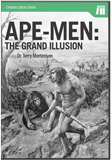
Review of New Fossils Found in Georgia
News Source
- National Geographic News: “Odd Fossil Skeletons Show Both Apelike and Human Traits”
A team reporting this week in the journal Nature announces the discovery of the remains of four individuals found at the site of a medieval castle at Dmanisi in the former Soviet republic of Georgia. Dated at 1.77 million years old (by a yet unnamed method) and ascribed to Homo erectus, scientists claim that the fossils “fill crucial gaps in the story of our evolution.” Let’s take a closer look.
“[t]he newfound fossils [. . .] had unusually small brains and bodies compared with early H. erectus fossils from Africa.”
“If this [group] is Homo erectus, it is the most primitive and oldest one known,” claims study leader David Lordkipanidze of the Georgian National Museum. The National Geographic News article notes that the fossils appear to have been both “particularly primitive” and “noticeably different” from other H. erectus fossils because “[t]he newfound fossils [...] had unusually small brains and bodies compared with early H. erectus fossils from Africa,” and because, Lordkipanidze adds, “Their hands were still well adapted to life [in the trees].”
Yet the fossil remains also showed “modern human features [. . .] including long legs and a spine suited for long-distance running and walking.” The body proportions of the fossils are also considered more humanlike than “pre-Homo species,” and one scientist, Erik Trinkhaus of Washington University in St. Louis, emphasizes that “[w]hat is clear is that the overall anatomy is primarily for walking on the ground.”
Thus, the fossils, which the study authors see as filling a crucial gap in evolutionary understanding (and bridging the gap between ape-like ancestor and human), seem to show nearly every sign of being simply diminutive members of H. erectus, who walked as we do and who had, as Lordkipanidze stated, “modern human features.” As we note in Is there really evidence that man descended from the apes?, H. erectus was
smaller than the average human today, with an appropriately smaller head (and brain size). However, the brain size is within the range of people today and studies of the middle ear have shown that Homo erectus was just like us. Remains have been found in the same strata and in close proximity to ordinary Homo sapiens, suggesting that they lived together.
Indeed, H. erectus reminds us of H. floresiensis, the “hobbits” discovered in Indonesia ; plus a forthcoming AiG article on this week’s hobbit update regarding its wrist who were also fully human despite their small stature (despite recent yarn-spinning about the wrist bones). Finds like these, along with the Bible’s talk of giants, remind us that human variation has likely decreased in many ways over time—although the range of human body sizes today is still considerable.
As for the fossils’ hands, which are said to have been “still [a word underscoring the presupposition of evolution] well adapted” to living in trees, it is difficult for us to come to a definite conclusion with only the scientists’ assertion, rather than the fossils themselves, to examine! Our guess at this point is that while the hands may appear, relatively speaking, more ape-like than those of most “modern” Homo sapiens sapiens, the hands would nonetheless be much closer to our hands than to those of apes and will likely be morphologically within normal variation. Furthermore, it would be more ape-like feet—not hands—that would go farther in indicating a transitional form (human hands and ape hands are considerably more similar than human feet and ape feet are).
The hands would nonetheless be much closer to our hands than to those of apes.
Of course, ultimately, we are dealing with the fossilized remains of humans that lived in the past and, thus, both creationists and evolutionists have to fill in information we don’t know about them with information we do know—both starting with our different presuppositions. That is why evolutionists see evolution “everywhere” and creationists see God’s handiwork everywhere. And that is why, even if a fossil find did show signs of transitional status (not that anyone has found a fossil that truly does), we will always take God at His Word first and then seek to discover how the facts fit. You will note that evolutionists do the same in presupposing that evolution has occurred and then attempt to interpret the facts in that framework. Problem is, in their case, when the facts don’t fit, the plasticity of evolutionary definitions and theory has to be kicked in. Not so with the Word of God.
Interestingly, it is Trinkhaus who neatly sums up our viewpoint. “They were little people with little brains—that doesn’t really surprise me.”
Further Reading
- Did Humans Really Evolve from Apelike Creatures?
- Homo erectus to Modern Man: Evolution or Human Variability?
- How Different is the Cranial-Vault Thickness of Homo Erectus from Modern Man?
- People Were Always People!
- Get Answers: Human Evolution, Ape-Man
For More Information: Get Answers
Remember, if you see a news story that might merit some attention, let us know about it! (Note: if the story originates from the Associated Press, FOX News, MSNBC, the New York Times, or another major national media outlet, we will most likely have already heard about it.) And thanks to all of our readers who have submitted great news tips to us. If you didn’t catch all the latest News to Know, why not take a look to see what you’ve missed?
(Please note that links will take you directly to the source. Answers in Genesis is not responsible for content on the websites to which we refer. For more information, please see our Privacy Policy.)
Recommended Resources

Answers in Genesis is an apologetics ministry, dedicated to helping Christians defend their faith and proclaim the good news of Jesus Christ.
- Customer Service 800.778.3390
- © 2024 Answers in Genesis



